Ideal for cool climates, but at the same time giving a rich harvest, the Marfa F1 tomato
The Dutch vegetable crop, named by its Russian name - the Marfa tomato - immediately attracted the attention of many fans of nightshades with its positive characteristics, high fruiting rate, disease resistance, good adaptation to weather changes and ease of care. But the main merit of the tomato is its ability to take root and delight with delicious vegetables in such cold regions where heat-loving crops cannot survive even a day.
Characteristics and description of the variety
Bred by Dutch breeders. Suitable for cultivation in the central and northern regions of the country.
The species is indeterminate, tall, the stem height reaches 1.7 m. The bush is not spreading, with medium foliage. The leaves are small, light green in color. The inflorescences are simple, the first inflorescence is formed after the 7th leaf, the rest - every 3 leaves. The root system is powerful.
Important! This is a late-ripening hybrid. From the moment of emergence of seedlings to full maturity, 135 days pass.
It is distinguished by the presence of immunity to the main diseases of the nightshade family, such as fusarium wilt, tobacco mosaic, verticillium and cladosporiosis.
The variety is well adapted to unfavorable weather conditions and can withstand sudden drops in temperature.
The productivity is high, up to 7 kg of vegetables are harvested from 1 bush.
A tall plant requires obligatory garter. Stepping is carried out regularly.
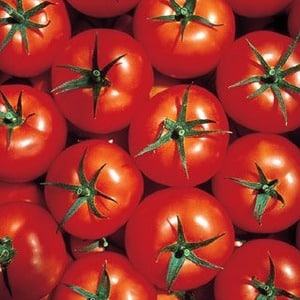
In the photo on the right is a tomato Marfa f1.
The fruits are large, weight up to 150 g, round in shape, bright red in color, juicy, not watery. The skin is smooth, dense, there are few seeds. The taste is sweet with sourness. The purpose of tomatoes is universal; they are well suited for fresh consumption; juices, ketchups, and sauces are made from them. Suitable for whole fruit canning.
They are subject to long-term storage and can withstand transportation over long distances. During storage, vegetables do not crack, they retain their presentation for quite a long time, so the variety is often grown for sale.
How to grow seedlings
Sowing of seeds begins 60 days before planting seedlings in closed ground; transplanting into open beds takes place a little later.
Seeds do not need disinfection before sowing. They undergo all necessary processing before sale. Only the soil prepares itself. The soil mixture is made from garden soil and humus. You can add a little washed river sand to lighten the soil. The grains are laid to a depth of 1.5 cm, covered with peat, moistened with a spray bottle and the planting containers are placed in a warm and dark place.
You can sow in a common wooden box or in separate plastic glasses and peat pots.
After the first shoots appear, the containers are moved to a well-lit place. Moisten the soil as the top layer dries with warm, settled water. For watering use small watering cans or a regular tablespoon.
When two true leaves appear, the seedlings are picked and placed in individual containers. During this period they carry out first feeding liquid complex fertilizer.
2 weeks before planting, seedlings begin hardening by taking the seedlings out into the open air for 2–3 hours.The time spent outside gradually increases to 16 hours. The temperature in the room at night where the seedlings are located drops to 12–13 °C.
How to grow tomatoes
After 2 months, the seedlings can be moved to the greenhouse. Tomatoes should be planted in open beds a little later, when the soil has completely warmed up. For 1 sq. m place no more than 3 bushes to avoid crowded planting. They are planted in a checkerboard pattern so that the plants do not suffer from lack of sunlight. With this placement, the bushes are well ventilated, which prevents the development of fungal diseases.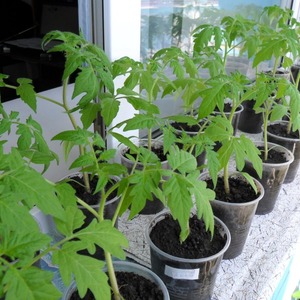
The soil for planting is prepared in the fall. The earth is dug up and treated with copper sulfate (1 tablespoon per 10 liters of warm water). In the spring, another fertilizing is applied in the form of peat, humus and sawdust. Add 3 tbsp to this mixture. l. superphosphate and 500 g of wood ash. Then the soil is dug up again and treated with lime solution. All this is done 10 days before transplanting the seedlings into the ground.
After transplanting the seedlings into shallow holes, the soil is moderately watered, loosened, hilled and mulched with straw. It is useful to spray young bushes with a solution of Fitosporin to prevent fungal and viral diseases.
Regular watering is established as the seedlings take root in the new location. Always water strictly at the root, avoiding moisture getting on the leaves, no more than 2 times a week. The culture responds well to drip irrigation. To do this, place a plastic bottle without a bottom in the root system and pour water into it, which gradually penetrates to the roots.
They begin to plant the crop immediately after transplantation. The plant is formed into 1 or 2 stems, removing all stepsons above the third cluster.
Fertilizing is carried out 3 times per season with a full range of fertilizers:
- The first fertilizing is applied during flowering;
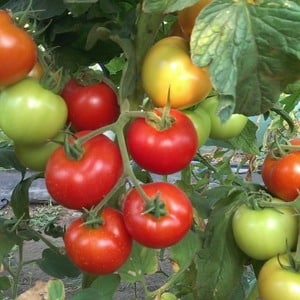
- the second - during fruit set;
- The third time is fed during the fruiting period.
A tall crop requires obligatory garter. A strong support in the form of wooden stakes or metal rods is installed next to each bush. In the future, branches are also attached to this support, otherwise they will not withstand the weight of the fruit.
The garter is especially important during mass ripening, when ripe vegetables noticeably weigh down the fruiting clusters, as can be seen in the photograph.
Diseases and pests
The culture has established itself as a variety resistant to major diseases of the nightshade family. For the purpose of prevention, treatment with copper sulfate is carried out, which reduces the risk of developing fungal diseases. Prevention also includes moderate watering, loosening the soil and regular weeding. Compliance with the rules of crop rotation and agricultural technology helps strengthen the plant’s immunity.
Young tomatoes suffer from aphids, whiteflies, thrips and slugs. In the fight against these parasitic insects, spraying with a decoction of celandine or industrial insecticides helps. But do not forget that the use of chemistry is possible only before the first ovaries appear.
Treating the stem with a warm soapy solution will save you from aphids. And ammonia will help get rid of slugs.
One of the most effective preventive methods is regular inspection of plants for the presence of pests. Systematic monitoring of the condition of tomatoes will save them from pest invasion, and a small number of parasitic insects can be easily dealt with using traditional methods, without the use of chemicals.
The nuances of growing in open ground and in a greenhouse
The Dutch hybrid is recommended for cultivation in all regions of our country, including the Urals and Siberia. In cold regions with short summers, it is recommended to grow tomatoes in greenhouses, otherwise constant exposure to cold can affect the quantitative indicator, reducing it by 30%.
On a note. The growth of greenhouse and outdoor plants is practically the same, but the fruiting rate is usually slightly higher in greenhouses.
In greenhouses, it is especially important to monitor the air temperature and humidity of the beds. This is where infections and mold are most likely to develop. Regular ventilation of closed structures reduces the risk of disease and destroys the habitual habitat of some insect pests.
Harvesting and application
The collection of ripe vegetables begins in the second half of July, closer to August and lasts until the first frost. Vegetables ripen quickly, in whole bunches, which makes them much easier to collect. Ripe vegetables can be stored for up to 35 days in a cold room without losing their appearance or taste.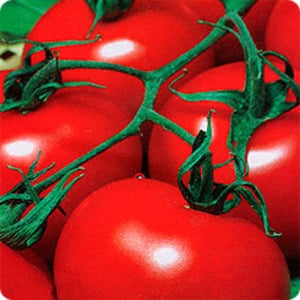
Universal use in cooking. Tomato is great for pickling, marinades And conservation. Preserves taste when preparing tomato products: lecho, juices, ketchups, pastes.
Well suited for any fresh salads and for hot and vegetable dishes such as stews or mashed potatoes. It is baked with meat and other vegetables. Small-sized tomatoes are used for whole-fruit canning.
Vegetables are subject to long-term storage and retain their appearance well during long-term transportation. These factors make it possible to grow tomatoes for sale, which is what many entrepreneurs do, seeing considerable benefits.
Advantages and disadvantages
Significant positive aspects of the Marfa f1 tomato:
- ability to take root in any region;
- ease of care;
- high yield;
- adaptation to any climatic conditions;
- disease resistance;
- excellent taste of fruits;
- long storage;
- good transportability;
- Possibility of growing for sale.
The disadvantages include:
- mandatory garter;
- obligatory stepsoning;
- the impossibility of independently selecting seeds for the next planting.
Farmer reviews
Opinions about the Marfa f1 tomato convince of the reliability of the culture. Many of those who planted a hybrid are not going to give it up, despite the fact that seeds need to be purchased every time. However, the price suits gardeners.
Here are some opinions from Martha fans: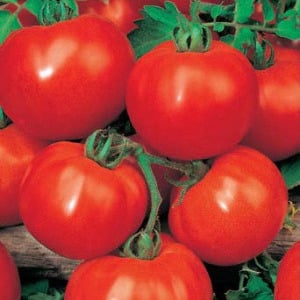
Evgeniy, Kirov:
“Our summer is strange, one might say that it doesn’t exist in the north. And you always want good tomatoes. I planted a hybrid for the first time. Met all my expectations. I will plant again."
Tatyana, Taganrog:
“I didn’t devote much time and effort to the hybrid. I just tied it up, watered it and fed it. I was pleased with the result. I made stock of vegetables for the whole winter, and still had enough to give to the neighbors to try. I'm very pleased. I’ll definitely plant more.”
Conclusion
The hybrid tomato Marfa has absorbed all the qualities that vegetable growers are guided by when choosing the next crop to plant on their plot.
High yields, good adaptation to any climate, high disease resistance, ease of care and reliable assessments by experienced vegetable growers make the species increasingly popular and strengthen the position of tomato among hybrid varieties.